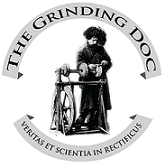After a long hiatus due to the COVID-19 pandemic, The Grinding Doc video series on Cutting Tool Engineering's website resumes with a special two-hour episode about Cylindrical Master 2020, an Excel program developed by Dr. Jeffrey Badger, aka The Grinding Doc. The 105th episode of The Grinding Doc video series provides a detailed description of the Cylindrical Master program that Badger developed during the pandemic.
The Excel program is available to anyone who takes the Grinding Doc's one-day virtual Zoom course on Cylindrical Grinding. The course, which will be held March 1, offers attendees a thorough understanding of cylindrical-plunge grinding and cylindrical-traverse grinding that should enable them to increase feedrates, eliminate chatter, increase form-holding and deal with burning.
To learn more about the March 1st Cylindrical Grinding course, visit the Grinding Doc's website.
The Excel program also is available to those who purchase Badger's Book of Grinding or who sign up for his regular three-day course.
About Jeffrey Badger, Ph.D., and the Grinding Doc Video Series: Thanks to his work as an independent grinding consultant and the author of the "Ask the Grinding Doc" column in Cutting Tool Engineering magazine, Badger routinely receives questions about grinding from shops all over the world. Through the magazine column and this video series, he provides shops with the insight and guidance they seek.
For more information about the Grinding Doc, visit his website here.
Contact Details
Related Glossary Terms
- burning
burning
Rotary tool that removes hard or soft materials similar to a rotary file. A bur’s teeth, or flutes, have a negative rake.
- chatter
chatter
Condition of vibration involving the machine, workpiece and cutting tool. Once this condition arises, it is often self-sustaining until the problem is corrected. Chatter can be identified when lines or grooves appear at regular intervals in the workpiece. These lines or grooves are caused by the teeth of the cutter as they vibrate in and out of the workpiece and their spacing depends on the frequency of vibration.
- cylindrical grinding
cylindrical grinding
Grinding operation in which the workpiece is rotated around a fixed axis while the grinding wheel is fed into the outside surface in controlled relation to the axis of rotation. The workpiece is usually cylindrical, but it may be tapered or curvilinear in profile. See centerless grinding; grinding.
- grinding
grinding
Machining operation in which material is removed from the workpiece by a powered abrasive wheel, stone, belt, paste, sheet, compound, slurry, etc. Takes various forms: surface grinding (creates flat and/or squared surfaces); cylindrical grinding (for external cylindrical and tapered shapes, fillets, undercuts, etc.); centerless grinding; chamfering; thread and form grinding; tool and cutter grinding; offhand grinding; lapping and polishing (grinding with extremely fine grits to create ultrasmooth surfaces); honing; and disc grinding.

